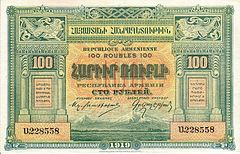The ruble (Armenian: ռուբլի, Russian: рубль) was the independent currency of the First Republic of Armenia and the Armenian Soviet Socialist Republic between 1919 and 1923. It replaced the first Transcaucasian ruble at par and was replaced by the second Transcaucasian ruble after Armenia became part of the Transcaucasian Soviet Federal Socialist Republic. No subdivisions of the ruble were issued and the currency existed only as banknotes.
 100 rubles (1919) | |
| Denominations | |
| Banknotes | 5, 10, 25, 50, 100, 250, 500, 1,000, 5,000, 10,000, 25,000, 100,000, 500,000, 1,000,000, 5,000,000 rubles |
| Coins | None Issued |
| Demographics | |
| Date of introduction | August 1919 |
| User(s) | |
| Issuance | |
| Printer | Waterlow and Sons |
| This infobox shows the latest status before this currency was rendered obsolete. | |
Banknotes edit
Provisional cheques were issued by the First Republic of Armenia in denominations of 5, 10, 25, 50, 100, 250, 500, 1,000, 5,000, and 10,000 rubles.[1] Most were quite crudely printed with mostly Russian text. However, three actual banknotes in denominations of 50, 100 and 250 rubles were printed in the UK by Waterlow and Sons Ltd. The notes were designed by artists Arshak Fetvadjian and Hakob Kojoyan. These notes are adorned with Armenian, French, and Russian text.
The Armenian SSR issued denominations between 5,000, 10,000, 25,000, 100,000, 500,000, 1,000,000, and 5,000,000 rubles. These notes bore Armenian and Russian texts together with communist slogans in various languages on the reverses.
| 5 ruble 1919 | 50 ruble 1919 | 250 ruble 1919 | 500 ruble 1919 | 1000 ruble 1919 | 5000 ruble 1919 | 10000 ruble 1919 |
| 50 ruble 1920(real) | 100 ruble 1920(real) | 250 ruble 1920(real) |
See also edit
References edit
- ^ Linzmayer, Owen (2013). "Armenia". The Banknote Book. San Francisco, CA: www.BanknoteNews.com.
- Pick, Albert (1990). Standard Catalog of World Paper Money: Specialized Issues. Colin R. Bruce II and Neil Shafer (editors) (6th ed.). Krause Publications. ISBN 0-87341-149-8.